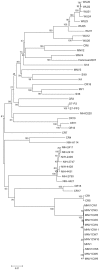Diversity of murine norovirus strains isolated from asymptomatic mice of different genetic backgrounds within a single U.S. research institute
- PMID: 21738664
- PMCID: PMC3125191
- DOI: 10.1371/journal.pone.0021435
Diversity of murine norovirus strains isolated from asymptomatic mice of different genetic backgrounds within a single U.S. research institute
Abstract
Antibody prevalence studies in laboratory mice indicate that murine norovirus (MNV) infections are common, but the natural history of these viruses has not been fully established. This study examined the extent of genetic diversity of murine noroviruses isolated from healthy laboratory mice housed in multiple animal facilities within a single, large research institute- the National Institute of Allergy and Infectious Diseases of the National Institutes of Health (NIAID-NIH) in Bethesda, Maryland, U.S. Ten distinct murine norovirus strains were isolated from various tissues and feces of asymptomatic wild type sentinel mice as well as asymptomatic immunodeficient (RAG 2(-/-)) mice. The NIH MNV isolates showed little cytopathic effect in permissive RAW264.7 cells in early passages, but all isolates examined could be adapted to efficient growth in cell culture by serial passage. The viruses, although closely related in genome sequence, were distinguishable from each other according to facility location, likely due to the introduction of new viruses into each facility from separate sources or vendors at different times. Our study indicates that the murine noroviruses are widespread in these animal facilities, despite rigorous guidelines for animal care and maintenance.
Conflict of interest statement
Figures



References
-
- Green KY. Caliciviridae: The Noroviruses; D M K, P H, editors. Philadelphia: Lippincott Williams & Wilkins; 2007. pp. 949–979.
-
- Kaufman SS, Chatterjee NK, Fuschino ME, Morse DL, Morotti RA, et al. Characteristics of human calicivirus enteritis in intestinal transplant recipients. J Pediatr Gastroenterol Nutr. 2005;40:328–333. - PubMed
-
- Jiang X, Wang M, Wang K, Estes MK. Sequence and genomic organization of Norwalk virus. Virology. 1993;195:51–61. - PubMed
-
- Lambden PR, Caul O, Ashley C, Clarke IN. 1993. Sequence and genome organization of a human small round structured (Norwalk-like) virus.
Publication types
MeSH terms
Grants and funding
LinkOut - more resources
Full Text Sources
Medical

